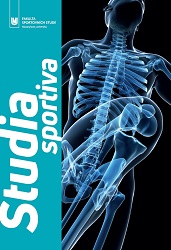Diagnostics of isometric and isokinetic strength in junior elite tennis players within the context of muscular dysbalances
Diagnostics of isometric and isokinetic strength in junior elite tennis players within the context of muscular dysbalances
Author(s): Tomáš Vodička, Tomáš Vespalec, Jiří Pačes, Jindřich Pavlík, Jiří ZhánělSubject(s): Sports Studies
Published by: Masarykova univerzita nakladatelství
Keywords: Isokinetic dynamometry; isometric dynamometry; muscular dysbalances; prediction of injury; tennis
Summary/Abstract: This research aims to determine the strength level of muscle groups in wrist and forearm and to assess lateral differences in junior tennis player group (TEN, n = 10, aged 12–14) and a control group of boys who do not perform any sport activity (CS, n=10, aged12–14) by isometric (hand dynamometer GRIP-D TKK 5401, Takei, Japan) and isokinetic dynamometry (dynamometer Humac Norm CSMI, Stoughton, USA) methods. Diagnostics of concentric extension and flexion was carried out in concordance with Ellenbecker methodology (1991) in angular velocities of 90°/s and 300°/s, results are given in Newton metres (Nm). Data analysis proved substantive insignificant differences between TEN and CS group as long as age, body height and weight are concerned. Isometric dynamometry: using Cohen’s d there were proved substantially significant differences in the strength of dominant extremity in favour of TEN group (d = 0.76) and lateral difference in strength level of right and left upper extremity in TEN group TEN (d = 0.60). Isokinetic dynamometry: in angular velocity of 90°/s were proved substantially significant differences between TEN and CS group in the strength of extensors (d = 1.16) and flexors of right wrist (d = 1.33) as well as in extensors (d = 0.83) and flexors (d = 0.99) of left wrist in favour of TEN group. Similarly, there was proved substantially significant lateral difference in strength level of wrist flexors of right and left hand (d = 0.84). In angular velocity of 300°/s there were proved substantially significant differences between TEN and CS group in favour of TEN group, both in right wrist extensors (d = 0.94) and flexors (d = 1.39). Substantially significant differences in favour of TEN group have been proved also in non dominant upper extremity, both in left wrist extensors (d = 1.27) and flexors (d = 1.12). Neither in TEN nor CS group were proved substantially significant lateral differences in strength of wrist extensors and flexors – with the exception of lateral differences between extensors (d = 0.62) in CS group. Values obtained by assessment of extensors and flexors strength ratio in both TEN and CS groups in both angular velocities signal an increased risk of injury incidence in all cases. From conclusions described above, it is obvious that long-term game and training load significantly increases the level of maximal strength in junior elite tennis players in comparison with the group of their peers who do not perform any sport activity.
Journal: Studia sportiva
- Issue Year: 11/2017
- Issue No: 1
- Page Range: 25-36
- Page Count: 11
- Language: English

